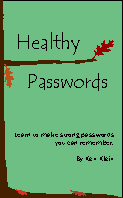.

.
.
Wireless Protection
Securing your home wireless network
Routers are the most important infrastructure equipment in your home. They are usually a small box connected to your phone or cable television line. They connect your home to the internet. Routers are also the way others can get into your home network.
Every router sold comes with default passwords. Most manufacturers have one or two default passwords for their equipment. At a minimum, you should change your router's default passwords.
The most common user-name and password for home routers is "admin" for both the username and password. A quick internet search will give you a listing of default admin passwords by router manufacturer.
If you leave your router password at the default and your router allows remote configuration, anyone can connect to your router and reconfigure it.
Most major router manufacturers are listed here. If you've never touched your router or are unsure, follow the link below to your manufacturers site and learn how to configure your router.
- ActionTec Electronics
- Adtran Inc.
- Alvarion, Inc.
- Apple
- Aruba Networks, Inc.
- Asanté Technologies Inc.
- Asus
- Belkin
- Brocade Communications
- Buffalo Technology
- Cisco / Linksys
- D-Link
Once you know how to configure your wireless, you need to do at least two things:
-
Change the router's admin password. Use what you learned from reading healthy passwords. This should be a password worthy of a high risk site.
-
Configure encryption. In this case, you will be setting up a passkey. Since you may have friends who will connect to your wireless, you should not use one of your password sandwiches (read Healthy passwords). Instead create a nice passkey. If you live in an apartment, a tight suburb development or a college campus, it should be a long passkey. A short sentice is on good way. For example, you could use something like a movie line, such as "Here's#looking#at#you"
Methods of Encryption
WiFi™ is not a manufacturer or brand of equipment. It's a testing process similar to the United States' UL or the European Union's CE programs. Products must be tested to meet the respective agency standards before they can apply the agencies label to their goods.
If your network equipment has the WiFi™ label and was manufactured after March 2006, it will offer an encryption called WPA-2. If your device offers WPA-2, use it. If it does not, buy a new device and configure it to use WPA-2.
Configuration of Home WiFi™ varies greatly amongst manufacturers. Most newer WIFI equipment will offer at least five options for security:
SSID Broadcast
The SSID is the name of the network. Hiding the name does not change much in terms of security. Hiding this won't slow down the geek next door, but it will hinder you every time a guest needs to use your network or you get a new device.
MAC Address Filtering
MAC address filtering will prevent a casual user from getting onto your network, but like hiding SSID, the geek next door will quickly get around this. Also, if you have people visit your house and access your wireless network, maintaining this type of feature will be very cumbersome.
WEP
This is the oldest type of wireless encryption. There are many widely available programs which will quickly break WEP encryption, so like the previous settings, the geek next door may need an extra few minutes to break WEP.
WPA
This was meant to be an interim solution between WEP and WPA/2. WPA is more secure than WEP, but our geek next door can still break this.
WPA/2
Currently, this is the most secure form of wireless encryption available in home networking equipment. The key to making this secure is to use a strong wireless password. If you're really paranoid, you can go up to 63 characters for your password. A casual home user should have a password no less than 10 characters. If you live in a large apartment complex in Silicon Valley, or on a technical college campus, you may want to double that length.
Using Hotspots away from home
Free WIFI™ (Worst)
You must be very careful using any free WIFI™. A worst case issue with free WIFI™ may be where a criminal sets up a wireless access point in an airport or near a cafe for the sole purpose of fraud. For more information read Healthy Passwords.
Pay per use WIFI™ (Better)
Pay per use WIFI™ is normally a service run by third-party carriers or providers. As long as the service uses some form of encryption it will be safer than free WIFI™. In many cases the provider will require you to use their software to connect. If you are not sure that your connection is encrypted, call the companies support number and ask. If it is not, you should not be paying for it. For more information read Healthy Passwords.
Cellular Card (Best)
All major cellular carriers now offer data services for internet access via their cellular network. Cellular cards are the safest way to connect while travelling. Just be certain it is connecting via cellular and not using WIFI™ when available. For more information read Healthy Passwords.
Hotel Internet (Hit or Miss)
Hotel internet comes in two flavors (WIFI™ and wired). Either flavor is like a hybrid between Free WIFI™ and pay per use WIFI™. Because access point may connect to hubs on segments where guests or employess can snoop unencrypted traffic, the only safe option for hotels is VPN. For more information read Healthy Passwords.
What is safe when traveling?
The only truely safe option is to use your cellular data card ensuring it will not switch to WIFI™ or use a VPN service. (See Third Party VPN Reviews
If you find yourself forced to use a questionable connection, try using only encrypted websites. Encrypted website URLs begin with HTTPS instead of HTTP. Unfortunately, unless the site offers https for everything, it will bounce back to regular http.

Learn to Make Strong Memorable Passwords Today |

|
| ISBN: 978-0615456850 |
.
|
|
||
|
Home | Live CD Listing | Password Worksheet | Third Party Ratings | Purchase | Errata | Contact | News | News Archive | Legal Copyright © 2011, Sustainable Alternatives, LLC | Ligonier, PA 15658 | 724-238-9560 | All Rights Reserved. |

|
|
 |
.

